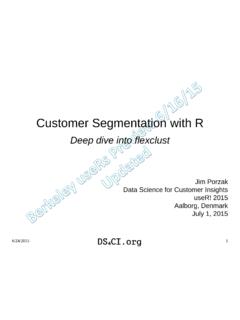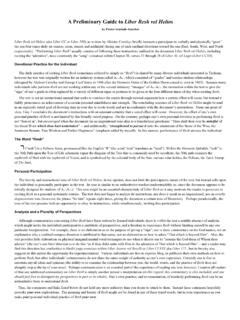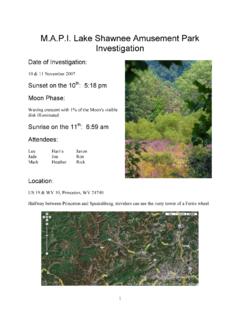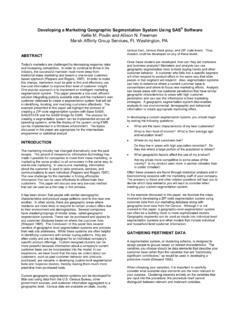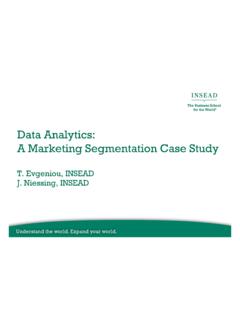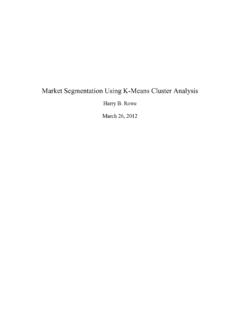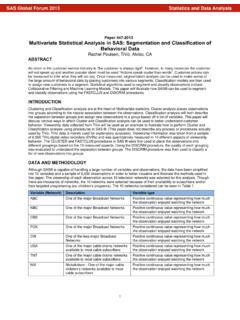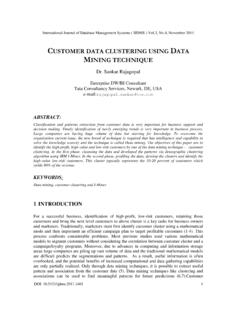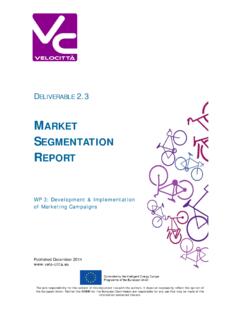Transcription of Customer Segmentation with R - Meetup
1 Customer Segmentation with RDeep dive into flexclustJim PorzakData Science for Customer InsightsBay Area useRGroupMountain View, CA September 1, 20159/2/201519/2 and how to segment? binary choice deep issues of numbering and the best number of has real-world examples, references, and links to learn Segmentation Themes9/2/20153 How Used?StrategicTacticalLevel?GeneralDetai ledTime Constant?LongShortImpact (if correct)?1x Huge (Small)Implementation?SimpleComplex9/2/2 0154 How to Segment?Do I believe these? How can I use them?What will be impact?Many Segmentation Methods!
2 Today s Focus: Binary choice surveys Simplest of surveys to design & take. Cluster analysis is a great tool to understand how respondents fall into natural segments Methods also apply to any binary choice behavioral data sets. For examples of other Segmentation methods see archives at s Example Data SetThe volunteersdata set from the flexclust Australian volunteers responded to the survey which had 19 preference check boxes for motivations to volunteer. The question could look like:Q5. Please check all motivations that apply to you:9/2/20156 example socialise career lonely active community cause faith services children benefited network recognition Binary Choice Data Pick all that apply type question.
3 Not picking is not the opposite of picking an attribute. (item checked) != NOT (item unchecked) Totally unsupervised. We only specify the number of clusters we want. Two necessary criteria for a good cluster solution is stable ~ Repeatable with different random segments make sense to the business-Believable story AND actionable AND has anticipated major we use: flexclust by Fritz Leisch Allows different distance measures In particular, the Jaccard distance which is suited for binary survey data or optional properties lists. 1 is a yes to the question -it is significant.
4 0 is a does not apply not opposite of yes Predict(kcca_object, newdata) to segment new customers. Additionally flexclusthas very good diagnostic and visualization tools. And, as an R package, it leverages the rest of the R flexclust Run (1 of 2)9/2/20159 Set up input to flexclust:Set up the parameters:Invoke kcca(): k-centroid cluster analysis library(flexclust)data("volunteers") vol_ch<-volunteers[-(1:2)] < (vol_ch)fc_seed<-577## Why we use this seed will become clear belownum_clusters<-3## Simple example only three clusters (fc_seed) <-kcca( , k=num_clusters, , control=fc_cont, family=kccaFamily(fc_family))fc_cont<-new("flexclustControl")## holds @verbose<-1## verbose > 0 will show iterationsfc_family<-"ejaccard"## Jaccarddistance w/ centroid meansFirst few iterations:Results:## 1 Changes / Distsum: 1415 / ## 2 Changes / Distsum: 138 / ## 3 Changes / Distsum.
5 39 / Simple flexclust Run (2 of 2)9/2/201510summary( )## kccaobject of family 'ejaccard' ## call:## kcca(x = , k = num_clusters, family = kccaFamily(fc_family), ## control = fc_cont, TRUE)## ## cluster info:## size av_distmax_distseparation## 1 1078 ## 2 258 ## 3 79 ## ## no convergence after 30 iterations## sum of within cluster distances: Separation Plot9/2/201511 Each respondent plotted against the first two principal components of data. Color is cluster of each cluster. A thin line to other centroid indicates better separation (in real problem space) Solid line encloses 50% of respondents in cluster; dotted 95%.
6 <-prcomp( ) ## plot on first two principal components plot( , data = , project = , main = ..)Also known as neighborhood plot. Purpose: Help business partners visualize clusters and how respondents fall within cluster boundaries. IOW, are clusters real ?Segment Profile Plot9/2/201512 Header: segment #, Count, & % totalBar: proportion of response in line/dot: overall proportionGreyed out when response not important to differentiate from other clusters. BUT, can still be an important characteristic of clusterTick-box labelsbarchart( , "#", shade = TRUE, layout = c( @k, 1), main =.)
7 Purpose: Help business partners translate clusters into segment stories. IOW, describe the clusters in business friendly far: we ve used standard appendix for references and , we ll address three practical starting seeds will number ~ equal clusters differently. The numbering starting seeds will result in quite different clusters. The stability is no automatic way to pick optimum k. The best k Numbering Problemfc_reorder{CustSegs}Reorder clusters in a : fc_reorder(x, orderby= "decendingsize")9/2/201514 Two different seeds have nearly equal solutions, but are labeled differently:The Stability Problem9/2/201515 Three different seeds have quite different solutions:We need a simple way to classify each solution just use sizes of two biggest clusters: Simple Method to Explore Stability For a given k, run a few hundred solutions (incrementing seed each time): Re-order clusters in descending size order Save.
8 K, seed, cluster #, & count Call Size_1 the count for 1stcluster;Size_2 the count for 2ndcluster. Scatter plot w/ 2D density curves: Size_2 x Size_1 Solve for peak location9/2/201516 Stability Plot of kccaSolutions for k=39/2/201517fc_rclust{CustSegs}Generate a List of Random : fc_rclust(x, k, fc_cont, nrep= 100,fc_family, verbose = FALSE, FUN = kcca, seed = 1234, plotme= TRUE)The Best k Problem9/2/201518K=8 is smallest k with single peak is best stable must also validate segment stories are the best. Generate stability plots for k = 2, 3, .., 10:Segment Separation for best k = 8 (seed = 1333)9/2/201519 Profile Plot for best k = 8 (seed = 1333)9/2/201520 One Segment Story (k = 8,seed = 1333)9/2/201521 What We Covered Customer Segmentation background.
9 Deep dive into using flexclust on binary choice type data Example kcca() run The numbering problem. The stability problem Provisional rule-of-thumb that best k is min(k, for single peak contours) Next Steps Get typical respondent(s) closest to each centroid. Respondent flow plot between segments. Comments?Now is the time!APPENDIX9/2/201523 ReferencesFlexclust details start here:Leisch, F. A Toolbox for K-Centroids Cluster Analysis. Computational Statistics and Data Analysis, 51 (2), 526-544, , F. Package flexclust , CRAN, 2013 Leisch, F. Neighborhood graphs, stripes and shadow plots for cluster visualization.
10 Statistics and Computing, 20 (4), 457-469, to marketing start here:Dolnicar, S. A review of data-driven market Segmentation in tourism,Faculty of Commerce -Papers(2002)Dolnicar, S., Leisch, F. Winter Tourist Segments in Austria -Identifying Stable Vacation Styles for Target Marketing Action,Faculty of Commerce -Papers(2003)Dolnicar, S., Leisch, F. Using graphical statistics to better understand market Segmentation solutions. International Journal of Market Research (2013)For all of Sara and Fritz s work see: #other9/2/2015249/2/201525 Learning More Jim s CustSegspackage development at Tenure based Segmentation & subscription survival Subscription Survival for Fun & Profit: RFM based Segmentation Workshop at N Cal DMA lunch group Using R for Customer Segmentation workshop at useR!
